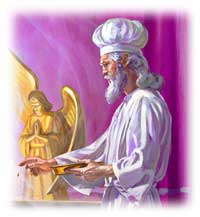

 |
|||||||||||||||||||||||||||
 |
|||||||||||||||||||||||||||
 |
 Then
each year, on the Day of Atonement, the sanctuary was cleansed from all
sins confessed during the past year (Leviticus 16). To effect this cleansing,
the High Priest made a special sacrifice of a consecrated goat. He then
carried its blood into the Most Holy Place and ministered before the ark
of the covenant which contained the Ten Commandments beneath the atonement
cover. The High Priest sprinkled this cleansing blood before the atonement
cover to show that the blood of Jesus, the coming Redeemer, would pay the
penalty for sin. The High Priest then symbolically removed the confessed
sins from the sanctuary and placed them on the head of another goat, which
was led out into the wilderness to die (Leviticus 16:20-22). Then
each year, on the Day of Atonement, the sanctuary was cleansed from all
sins confessed during the past year (Leviticus 16). To effect this cleansing,
the High Priest made a special sacrifice of a consecrated goat. He then
carried its blood into the Most Holy Place and ministered before the ark
of the covenant which contained the Ten Commandments beneath the atonement
cover. The High Priest sprinkled this cleansing blood before the atonement
cover to show that the blood of Jesus, the coming Redeemer, would pay the
penalty for sin. The High Priest then symbolically removed the confessed
sins from the sanctuary and placed them on the head of another goat, which
was led out into the wilderness to die (Leviticus 16:20-22).
This ceremony on the yearly Day of Atonement cleansed the sanctuary from sin. The people regarded it as a day of judgment because those who refused to confess and seek divine pardon for their sins were considered unrighteous and were “cut off from His [God’s] people” (Leviticus 23:29). What the High Priest did symbolically once a year, Jesus does once for all time as our High Priest (Hebrews 9:6-12). In the great judgment day He removes from the sanctuary the confessed sins of all who have accepted Jesus as Saviour. If we have confessed our sins, He will forever blot out the record of our sins at that time. This is the work of judgment that began in 1844. In 1844 when the hour of God’s judgment began in heaven and Jesus began His work of cleansing the heavenly sanctuary, a judgment hour message began to be preached throughout the world (Revelation 14:6-7). A future DISCOVER guide will deal with this special message. |